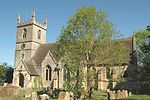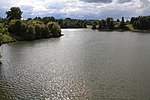Bear Hotel, Woodstock
Buildings and structures completed in the 13th centuryCoaching innsGrade II* listed pubs in OxfordshireHotels in OxfordshireReportedly haunted locations in South East England ... and 2 more
Restaurants in OxfordshireUnited Kingdom hotel stubs

The Bear Hotel is a hotel in Woodstock, Oxfordshire, located opposite The Oxfordshire Museum, not far from Blenheim Palace. It is one of England's original 13th-century coaching inns and has stone walls, oak beams, open fireplaces and an ivy facade. The hotel has 53 bedrooms and its restaurant has 2 A.A. Rosettes and 2 RAC Dining Awards. It is run by MacDonald Hotels and Resorts. Notable guests include Richard Burton and Elizabeth Taylor who stayed at the hotel on many occasions in the Marlboro suite.
Excerpt from the Wikipedia article Bear Hotel, Woodstock (License: CC BY-SA 3.0, Authors, Images).Bear Hotel, Woodstock
Rectory Lane, West Oxfordshire
Geographical coordinates (GPS) Address Nearby Places Show on map
Geographical coordinates (GPS)
| Latitude | Longitude |
|---|---|
| N 51.84673449337 ° | E -1.3564746014996 ° |
Address
Rectory Lane
OX20 1SY West Oxfordshire
England, United Kingdom
Open on Google Maps









